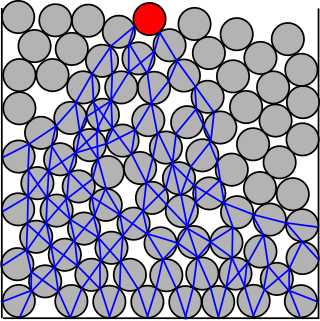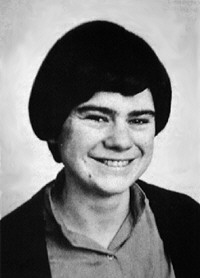
A micelle or micella is an aggregate of surfactant amphipathic lipid molecules dispersed in a liquid, forming a colloidal suspension. A typical micelle in water forms an aggregate with the hydrophilic "head" regions in contact with surrounding solvent, sequestering the hydrophobic single-tail regions in the micelle centre.

An antibubble is a droplet of liquid surrounded by a thin film of gas, as opposed to a gas bubble, which is a sphere of gas surrounded by a liquid. Antibubbles are formed when liquid drops or flows turbulently into the same or another liquid. They can either skim across the surface of a liquid such as water, in which case they are also called water globules, or they can be completely submerged into the liquid to which they are directed.

Smoothed-particle hydrodynamics (SPH) is a computational method used for simulating the mechanics of continuum media, such as solid mechanics and fluid flows. It was developed by Gingold and Monaghan and Lucy in 1977, initially for astrophysical problems. It has been used in many fields of research, including astrophysics, ballistics, volcanology, and oceanography. It is a meshfree Lagrangian method, and the resolution of the method can easily be adjusted with respect to variables such as density.
Parallel tempering, in physics and statistics, is a computer simulation method typically used to find the lowest energy state of a system of many interacting particles. It addresses the problem that at high temperatures, one may have a stable state different from low temperature, whereas simulations at low temperatures may become "stuck" in a metastable state. It does this by using the fact that the high temperature simulation may visit states typical of both stable and metastable low temperature states.

Peter V. Coveney is a Professor of Physical Chemistry, Honorary Professor of Computer Science, and the Director of the Centre for Computational Science (CCS) and Associate Director of the Advanced Research Computing Centre at University College London (UCL). He is also a Professor of Applied High Performance Computing at University of Amsterdam (UvA) and Professor Adjunct at the Yale School of Medicine, Yale University. He is a Fellow of the Royal Academy of Engineering and Member of Academia Europaea. Coveney is active in a broad area of interdisciplinary research including condensed matter physics and chemistry, materials science, as well as life and medical sciences in all of which high performance computing plays a major role. The citation about Coveney on his election as a FREng says: Coveney "has made outstanding contributions across a wide range of scientific and engineering fields, including physics, chemistry, chemical engineering, materials, computer science, high performance computing and biomedicine, much of it harnessing the power of supercomputing to conduct original research at unprecedented space and time scales. He has shown outstanding leadership across these fields, manifested through running multiple initiatives and multi-partner interdisciplinary grants, in the UK, Europe and the US. His achievements at national and international level in advocacy and enablement are exceptional".

In the context of chemistry and molecular modelling, a force field is a computational method that is used to estimate the forces between atoms within molecules and also between molecules. More precisely, the force field refers to the functional form and parameter sets used to calculate the potential energy of a system of atoms or coarse-grained particles in molecular mechanics, molecular dynamics, or Monte Carlo simulations. The parameters for a chosen energy function may be derived from experiments in physics and chemistry, calculations in quantum mechanics, or both. Force fields are interatomic potentials and utilize the same concept as force fields in classical physics, with the difference that the force field parameters in chemistry describe the energy landscape, from which the acting forces on every particle are derived as a gradient of the potential energy with respect to the particle coordinates.
A polymer brush is the name given to a surface coating consisting of polymers tethered to a surface. The brush may be either in a solvated state, where the tethered polymer layer consists of polymer and solvent, or in a melt state, where the tethered chains completely fill up the space available. These polymer layers can be tethered to flat substrates such as silicon wafers, or highly curved substrates such as nanoparticles. Also, polymers can be tethered in high density to another single polymer chain, although this arrangement is normally named a bottle brush. Additionally, there is a separate class of polyelectrolyte brushes, when the polymer chains themselves carry an electrostatic charge.
Multi-particle collision dynamics (MPC), also known as stochastic rotation dynamics (SRD), is a particle-based mesoscale simulation technique for complex fluids which fully incorporates thermal fluctuations and hydrodynamic interactions. Coupling of embedded particles to the coarse-grained solvent is achieved through molecular dynamics.
Philippe Blanchard has been a Professor of Mathematical Physics at Faculty of Physics, Bielefeld University since 1980. He is both director of the Research Center BiBoS and deputy managing director of the Center for Interdisciplinary Research at Bielefeld University.
The term file dynamics is the motion of many particles in a narrow channel.
Force matching is a research method consisting of test subjects attempting to produce a set forces that are equal to a set of more reliable reference forces.

The Plasmakristall-3 Plus laboratory was a joint Russian-German laboratory for the investigation of dusty/complex plasmas on board the International Space Station (ISS), with the principal investigators at the German Max Planck Institute for Extraterrestrial Physics and the Russian Institute for High Energy Densities. It was the successor to the PKE Nefedov experiment with improvements in hardware, diagnostics and software. The laboratory was launched in December 2005 and was operated for the first time in January 2006. It was used in 21 missions until it was deorbited in 2013. It is succeeded by the PK-4 Laboratory.

In the study of the physics of granular materials, a force chain consists of a set of particles within a compressed granular material that are held together and jammed into place by a network of mutual compressive forces.

Matjaž Perc is Professor of Physics at the University of Maribor in Slovenia, and director of the Complex Systems Center Maribor. He is member of Academia Europaea and among top 1% most cited physicists according to Thomson Reuters Highly Cited Researchers. He is Outstanding Referee of the Physical Review and Physical Review Letters journals, and Distinguished Referee of EPL. He received the Young Scientist Award for Socio-and Econophysics in 2015. His research has been widely reported in the media and professional literature.
Richard Anthony Lewis JonesFInstP FLSW is professor of Materials Physics and Innovation Policy at the University of Manchester having been professor of physics at the University of Sheffield until 2020.
Nikolay Victorovich Prokof'ev is a Russian-American physicist known for his works on supersolidity and strongly correlated systems and pioneering numerical approaches.
In mathematical physics, the diagrammatic Monte Carlo method is based on stochastic summation of Feynman diagrams with controllable error bars. It was developed by Boris Svistunov and Nikolay Prokof'ev. It was proposed as a generic approach to overcome the numerical sign problem that precludes simulations of many-body fermionic problems. Diagrammatic Monte Carlo works in the thermodynamic limit, and its computational complexity does not scale exponentially with system or cluster volume.

Elizabeth Gardner was a British theoretical physicist. She is best known for her groundbreaking work on a phase transition known as the Gardner transition and on disordered networks.

The Kaniadakis Gaussian distribution is a probability distribution which arises as a generalization of the Gaussian distribution from the maximization of the Kaniadakis entropy under appropriated constraints. It is one example of a Kaniadakis κ-distribution. The κ-Gaussian distribution has been applied successfully for describing several complex systems in economy, geophysics, astrophysics, among many others.










